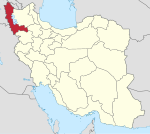Oshnavieh
Oshnavieh
سید علوی | |
|---|---|
town | |
 Oshnavieh | |
| Coordinates: 37°02′23″N 45°05′54″E / 37.03972°N 45.09833°ECoordinates: 37°02′23″N 45°05′54″E / 37.03972°N 45.09833°E | |
| Country | |
| Province | West Azerbaijan |
| County | Oshnavieh |
| Bakhsh | Central |
| Government | |
| Population (2016 Census) | |
| • Total | 39,801 |
| Time zone | UTC+3:30 (IRST) |
| • Summer (DST) | UTC+4:30 (IRDT) |
Oshnavieh (Persian: اشنويه, romanized: Oshnavīyeh;[1] Kurdish: شنۆ, romanized: Şino[2][3]) is the capital city of Oshnavieh County, West Azerbaijan Province in Iran. At the 2016 census, its population was 40,000 in 2000 families.[4]
History[]
Oshnaviyeh lies on the historic route from Urmia basin to Rawandiz over the Kalashin Pass. An Urartian stele from about 800 BCE exist near the city. After the Mongol invasion, the city became the seat of the Nestorian Church for a brief moment.[5]
Medieval geographers from the 10th century wrote that the city was fair-sized, attached to Urmia, fertile and having good pasture. Kurds from the Hadhabani tribe would settle in the area during the summer, pasture their livestock and sell their products for manufactures and textiles from the city. The city came under the rule of the Rawadids in the 10th century and continued to flourish. The city also fostered scholars and traditionalists. Ali ibn al-Athir wrote in 1205/6 that Nusrat al-Din Abu Bakr of the Eldiguzids handed over the city to the ruler of Maragheh ʿAlāʾ-al-Din Qara Sonqor. In 1226, the city was under the Ivāʾiya Kurds until its capture by Jalal ad-Din Mingburnu. In 1220/1, when Yaqut al-Hamawi passed the city, the city was in ruins, but had been rebuilt by the time of the visit of Hamdallah Mustawfi. Mustawfi described the city as being Sunni, in a rural district of 120 villages and producing a total revenue worth 19,300 dinars annually. It was mentioned by traveller Fraser in 1840 that the city was populated Zerza Kurds, whose presence is possibly attested as being present in the city as early as the 14th century. In the 19th century, the population was mostly Kurdish with a small Nestorian population which perished during Seyfo.[5]
In 1909, it was equal to 1287 AH, Oshnavieh was conquered byOttomans and the people were slaughter by them. The presence of the Ottomans and the Russians in this region caused human and financial losses to the people of Oshnavieh. After the Russians, it was the turn of the Assyrians to raid the city, who had no mercy on women and children. The war between Assyrians and Ottomans followed by severe starving cosequentaly people moved toMossul and Kirkuk ou of fear and hunger. Following these events, only a few hundred people remained from the 13,000 people of Oshnoyeh at that time.<[6]
Iran-Iraq war[]
At the time of Iran-Iraq war, Ba'athist Iraq regime bombed some localities of Oshnavieh in the province of West Azerbaijan—on 2 August 1988—by applying chemical bombs against them;[7] and as a consequence of those attacks, approximate 2700 persons were injured.[8]
References[]
- ^ Oshnavieh can be found at GEOnet Names Server, at this link, by opening the Advanced Search box, entering "-3077462" in the "Unique Feature Id" form, and clicking on "Search Database".
- ^ "Pêşmergeyên Rojhilatî derbasî nav bajarê Şino bûn!" (in Kurdish). 17 September 2019. Retrieved 21 March 2020.
- ^ "لە کوێستانەکانی شنۆ شەڕ لەنێوان سوپای پاسداران و گرووپێکی نەناسراو روویدا" (in Kurdish). 9 June 2018. Retrieved 21 March 2020.
- ^ "Census of the Islamic Republic of Iran, 1385 (2006)" (Excel). Statistical Center of Iran. Archived from the original on 2011-11-11.
- ^ a b Bosworth, C. E. (2002). "OŠNUYA". Encyclopedia Iranica.
- ^ "Oshnavieh History". Archived from the original on 29 November 2014.
- ^ "Anniversary of Oshnavieh bombard". tabnak.ir. Retrieved 11 June 2019.
- ^ "Oshnavieh bombard". farsnews.com. Retrieved 11 June 2019.
- Populated places in Oshnavieh County
- Cities in West Azerbaijan Province
- Iranian Kurdistan
- Kurdish settlements in West Azerbaijan Province
- Iraqi war crimes
- Oshnavieh County geography stubs

